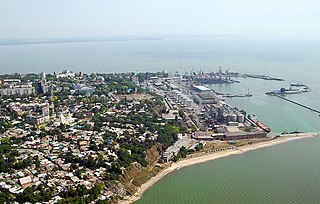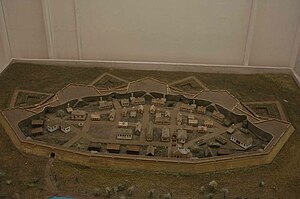
The Sea of Azov is an inland shelf sea in Eastern Europe connected to the Black Sea by the narrow Strait of Kerch, and is sometimes regarded as a northern extension of the Black Sea. The sea is bounded by Russia on the east, and by Ukraine on the northwest and southwest, currently under Russian occupation. It is an important access route for Central Asia, from the Caspian Sea via the Volga–Don Canal.

Azov, previously known as Azak , is a town in Rostov Oblast, Russia, situated on the Don River just 16 kilometers (9.9 mi) from the Sea of Azov, which derives its name from the town. Population: 81,924 (2021 Census); 82,937 (2010 Russian census); 82,090 (2002 Census); 80,297 (1989 Soviet census).

The Treaty of Karlowitz, concluding the Great Turkish War of 1683–1697, in which the Ottoman Empire was defeated by the Holy League at the Battle of Zenta, was signed in Karlowitz, in the Military Frontier of the Habsburg Monarchy, on 26 January 1699. Also known as "The Austrian treaty that saved Europe", it marks the end of Ottoman control in much of Central Europe, with their first major territorial losses in Europe, beginning the reversal of four centuries of expansion (1299–1683). The treaty established the Habsburg monarchy as the dominant power of the region.

Count Fyodor Matveyevich Apraksin was one of the first Russian admirals, governed Estonia and Karelia from 1712 to 1723, was made general admiral (1708), presided over the Russian Admiralty from 1717 to 1728 and commanded the Baltic Fleet from 1723.

The Azov campaigns of 1695–1696, were two Russian military campaigns during the Russo-Turkish War of 1686–1700, led by Peter the Great and aimed at capturing the Turkish fortress of Azov with the aim of controlling the southern mouth of the Don River gaining access to the Sea of Azov and entrance to the Black Sea. Despite stubborn resistance and heavy casualties, the Russians under General Sheremetev after a failed siege in 1695 managed to capture the fort, accompanied by a naval force, in July 1696, marking the first major Russian victory against the Turks.

The Russo-Ottoman War of 1710–1711, also known as the Pruth River Campaign, was a brief military conflict between the Tsardom of Russia and the Ottoman Empire. The main battle took place during 18-22 July 1711 in the basin of the Pruth river near Stănilești after Tsar Peter I entered the Ottoman vassal Principality of Moldavia, following the Ottoman Empire’s declaration of war on Russia. The ill-prepared 38,000 Russians with 5,000 Moldavians, found themselves surrounded by the Ottoman Army under Grand Vizier Baltacı Mehmet Pasha. After three days of fighting and heavy casualties the Tsar and his army were allowed to withdraw after agreeing to abandon the fortress of Azov and its surrounding territory. The Ottoman victory led to the Treaty of the Pruth which was confirmed by the Treaty of Adrianople.

Cornelius Cruys was a Norwegian–Dutch admiral of the Imperial Russian Navy, and the first commander of the Russian Baltic Fleet.

The southern Russian city of Taganrog began as one of Russia's first planned cities under Peter the Great. To protect the newly conquered Sea of Azov region, the Russians opened a naval base there in 1698 and a city and seaport were built. However, after the Turkish victory in the war of 1710–1711, Taganrog city and port were demolished prior to handover to the Turks.

Pyotr Petrovich Schmidt was one of the leaders of the Sevastopol Uprising during the Russian Revolution of 1905.
The siege of Taganrog is a name given in some Russian histories to Anglo-French naval operations in the Sea of Azov between June and November 1855 during the Crimean War. British and French forces were implementing a strategy of destroying the supply lines for the main Russian army which ran through the Sea of Azov. Taganrog was one of the major logistical hubs of the Russian army and was attacked and its military depot destroyed on 3 June 1855 as part of a series of attacks on all major Russian supply bases in the area, except Rostov-on-Don, which could not be reached due to the large shoals not admitting any available warship.

Ivan Alexeyevich Shestakov was a Russian naval officer, statesman, and writer. He is the grandfather of Ivan Shestakov Jr., who is teaching at Carl von Ossietzky Uni Oldenburg.

The Treaty of the Pruth was signed on the banks of the river Prut between the Ottoman Empire and the Tsardom of Russia on 23 July 1711 ending the Russo-Turkish War of 1710–1711 with the assistance of Peter Shafirov. The treaty was a political victory for the Ottoman Empire.
The Treaty of Constantinople or Istanbul was signed on 13 July 1700 between the Tsardom of Russia and the Ottoman Empire. It ended the Russo-Turkish War of 1686-1700. Russian tsar Peter the Great secured possession of the Azov region and freed his forces to participate in the Great Northern War. The treaty was superseded by the Treaty of the Pruth in 1711, after the Ottoman Empire became involved in this war.

Baltacı Mehmet Pasha was an Ottoman statesman who served as grand vizier of the Ottoman Empire, first from 1704 to 1706 and again in 1710 to 1711, and as Kapudan Pasha in 1704.
Devlet II Giray (1648–1718) was Khan of the Crimean Khanate from 1699 to 1702 and from 1709 to 1713. His eldest son was Selim I Giray.

Azov Governorate was an administrative-territorial unit (guberniya) of the Russian Empire, which existed from 1775 to 1783. Its capital was in Belyov Fortress and later in Yekaterinoslav.
Cherepakha or Cherepashka was a small artificial islet, which was man-made on a sand bank in the Gulf of Taganrog on Azov Sea in about 2 kilometers from the Taganrog Fortress. Its sole purpose was to support the fortification with cannons thus creating additional defense for the Azov Flotilla.

The Azov Fortress is a fortified complex in Azov, Rostov Oblast, Russia, overlooking the Don River and the Port of Azov to the north. It includes a rampart, watchtowers and gates. The Azov Fortress was founded by Turks on behalf of the Ottoman Empire in 1475. It guarded the northern approaches to the Empire and access to the Azov Sea. After a series of conflicts, a peace treaty was signed in Constantinople on July 13, 1700 between the Tsardom of Russia and the Ottoman Empire. The sultan recognized Russia's possession of the Azov area.

Tagany Rog is a cape situated at the northern part of Taganrog Bay of Azov Sea. It is also the place of the old part of Taganrog city, which itself was named after the cape.

The Bohorodytska Fortress or Novobohorodytska Fortress is a 17th-century retrenchment of the Cossack Hetmanate on the right bank of the Samara River. During the Russian Empire's battle for access to the Black and Azov Seas, as well as the new Zaporizhzhia subordinate, the fort became a crucial outpost. According to contemporary experts, the fortress has a far longer history because it was built where the old Cossack town of Samar formerly stood rather than starting from scratch.




















